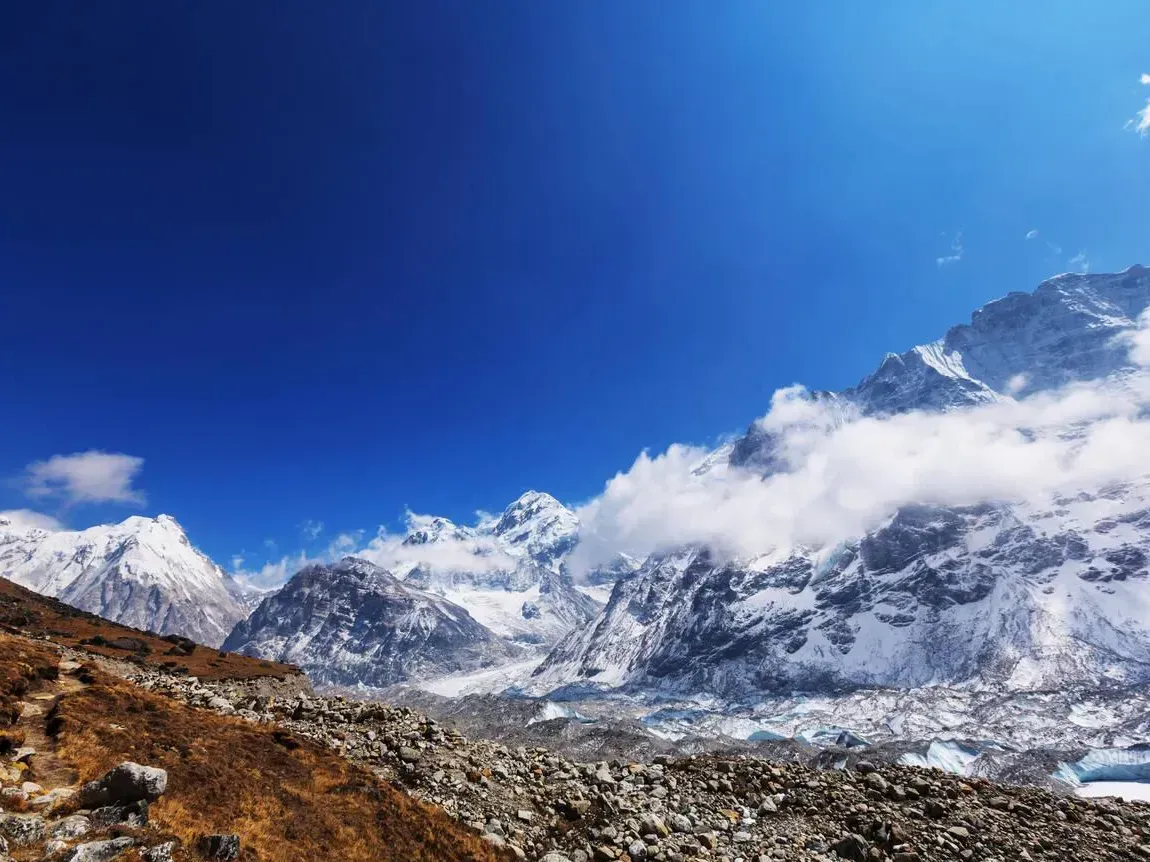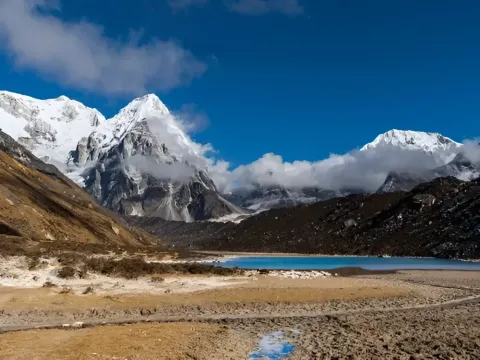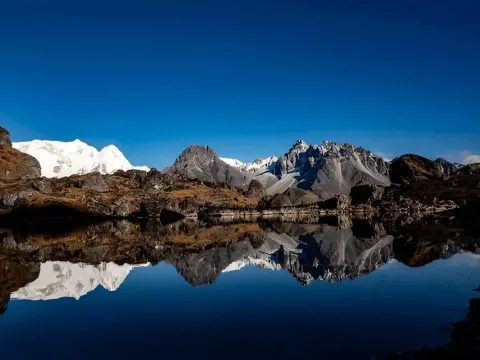Mount Kanchenjunga, the third-highest peak in the world, is one of the most majestic and revered mountains on Earth. Rising to an impressive height of...

The Kanchenjunga Circuit Trek is a remote and majestic adventure through the untouched landscapes surrounding the world’s third highest mountain, Kanchenjunga (8,586m). Spanning over three weeks, this trek offers spectacular views, challenging trails, rich cultural experiences, and encounters with diverse wildlife. This comprehensive guide by Explore Holiday Nepal is designed to help you prepare thoroughly and make the most of this epic journey.
Whether you’re an experienced trekker seeking a less crowded route or an adventure enthusiast passionate about high-altitude trekking, this guide covers everything—from the best time to visit and detailed daily itineraries to essential packing tips, permits, and cultural insights. Let's dive deep into the wonder of Kanchenjunga.
Kanchenjunga Circuit Trek is one of Nepal’s most remote and demanding trekking routes. Unlike the more popular Everest or Annapurna circuits, this trek traverses rarely visited trails in eastern Nepal, passing through pristine forests, traditional villages, and high alpine meadows. The trek’s allure lies in its combination of dramatic mountain scenery and cultural diversity, as trekkers encounter Lepcha, Limbu, and Sherpa communities along the way.
Starting from Bhadrapur after a flight from Kathmandu, the trail climbs through Ilam’s lush tea gardens, the rugged foothills of Taplejung, and finally into the high-altitude wilderness near Kanchenjunga. The route involves a mix of gradual ascents, steep climbs, and acclimatization days to help trekkers adjust to the altitude, making it both physically and mentally rewarding.
The trek boasts some of Nepal’s most spectacular and untouched landscapes. You will be rewarded with panoramic views of Kanchenjunga’s three main summits—Yalung, Central, and Kangbachen. Day trips to both the North and South Base Camps offer close-up views of the towering peak, a rare treat given the trek’s isolation.
Apart from natural beauty, the journey through quaint mountain villages like Ghunsa, Lelep, and Cheram immerses trekkers in the rich cultural fabric of the region. The diverse ethnic groups, with their unique customs and vibrant festivals, provide a culturally enriching experience. Additionally, the trek’s route passes through varied ecosystems—from rhododendron forests and alpine meadows to rugged cliffs—making wildlife sightings, including red pandas, musk deer, and Himalayan black bears, possible.
The itinerary spans 22 days, beginning with a flight from Kathmandu to Bhadrapur, followed by drives and multi-day trekking legs that gradually increase in altitude. Key stops include:
This well-paced itinerary balances challenging trekking days with rest and acclimatization, ensuring a safe and fulfilling experience.
Packing for the Kanchenjunga Circuit Trek requires careful consideration due to the trek’s long duration, varying weather conditions, and remote locations. Layered clothing is essential to adapt to fluctuating temperatures—from warm days in lower elevations to freezing cold nights in the high Himalayas. Start with moisture-wicking base layers to keep sweat away, add insulating mid-layers like fleece or down jackets, and finish with a waterproof and windproof outer shell to protect against rain and snow. Don’t forget thermal underwear, gloves, a warm hat, and a buff or neck gaiter for added protection against wind chill.
In addition to clothing, your gear list should include sturdy, waterproof trekking boots with good ankle support, comfortable socks, and gaiters to keep debris out. Essential equipment like trekking poles, a reliable headlamp with extra batteries, a good quality sleeping bag (rated for at least -10°C/14°F), and a durable backpack with rain cover are must-haves. Since this trek traverses remote areas, it’s important to carry personal hygiene items, sunscreen, insect repellent, water purification tablets, and a compact first aid kit. Explore Holiday Nepal also recommends bringing a few high-energy snacks and a camera to capture the spectacular scenery.
The Kanchenjunga Circuit is best trekked during the spring (March to May) and autumn (late September to November) seasons, when the weather is stable, and the views of the snow-capped peaks are at their clearest. Spring is particularly famous for blooming rhododendrons that paint the forests in vivid red and pink, creating breathtaking landscapes along the trails. The temperatures are moderate, making it comfortable for trekking, while autumn offers crisp air, minimal rainfall, and clear skies, providing excellent visibility of Kanchenjunga and surrounding Himalayan ranges.
Winter (December to February) brings harsh cold and heavy snowfall at higher altitudes, which can make the trek difficult and increase the risk of avalanches and frostbite. The monsoon season (June to August) is generally not recommended as heavy rains cause slippery trails, landslides, and leeches, making trekking dangerous and less enjoyable. Planning your trek during the ideal seasons helps ensure safer trail conditions and a more rewarding trekking experience. Explore Holiday Nepal offers customized trekking schedules to align with the best times to visit, maximizing your chances for success and enjoyment.
Preparing for the Kanchenjunga Circuit Trek requires a combination of physical training, mental readiness, and logistical planning. Due to the trek’s challenging terrain and high altitudes, building cardiovascular endurance and muscular strength is crucial. Start a training regimen at least two to three months before your departure, including activities like hiking with a weighted backpack, running, cycling, and stair climbing. Focus on strengthening your legs, core, and back to handle steep ascents and long walking days. Don’t neglect flexibility and balance exercises, which help reduce injury risks.
Mental preparation is equally important, as the trek involves several days in remote, isolated areas with limited communication. Familiarize yourself with high-altitude sickness symptoms and acclimatization strategies. Booking your trek with a reputable agency like Explore Holiday Nepal is highly recommended to ensure you have experienced guides, porters, and proper emergency support. Additionally, get all necessary permits well in advance and make sure your travel insurance covers high-altitude trekking. Adequate preparation not only enhances your safety but also ensures that you fully enjoy the incredible beauty and culture the Kanchenjunga Circuit has to offer.
The Kanchenjunga Circuit Trek takes you through one of Nepal’s most pristine and ecologically diverse regions, making it a haven for wildlife enthusiasts. The trek passes through Kanchenjunga Conservation Area, home to a variety of rare and endangered species. With luck and patience, trekkers may spot elusive animals such as the red panda, a shy and endangered mammal native to the eastern Himalayas. Other notable mammals include the Himalayan black bear, musk deer, and the agile snow leopard, although the latter is rarely seen due to its secretive nature.
Birdwatchers will also find the trek rewarding, as the area is rich with unique Himalayan bird species like the blood pheasant, Himalayan monal (Nepal’s national bird), and the satyr tragopan. The diverse flora—rhododendron forests, alpine meadows, and coniferous woodlands—supports a delicate balance of life. Explore Holiday Nepal recommends bringing binoculars and a camera with a zoom lens for better wildlife viewing and reminds trekkers to respect wildlife by maintaining a safe distance and minimizing noise, preserving the natural habitat for future generations.
The Kanchenjunga Circuit is not just a trek through mountains but also a journey through vibrant cultures and ancient traditions. The trail winds through villages inhabited by diverse ethnic groups, including the Lepcha, Limbu, Sherpa, and Rai communities. Each of these groups has its own distinct language, customs, and festivals that reflect a rich cultural tapestry. Visitors have the unique opportunity to experience traditional hospitality, stay in local teahouses, and participate in community festivals if their trek coincides with celebrations.
Many of these communities practice Tibetan Buddhism mixed with indigenous animistic beliefs, evident in the colorful prayer flags fluttering in the wind, the monasteries perched on hillsides, and the sacred mani stones carved with prayers. The Kanchenjunga region offers a glimpse into ancient lifestyles that have been preserved for centuries, away from the rush of modern life. Explore Holiday Nepal encourages trekkers to approach these encounters with respect and curiosity, fostering cultural exchange that enriches the trekking experience beyond the natural beauty of the mountains.
Solo trekking the Kanchenjunga Circuit is an exhilarating but demanding experience, best suited for highly experienced and well-prepared trekkers. The route is remote, less commercialized, and involves navigating challenging terrain with limited access to medical facilities or communication networks. Solo trekkers must be confident in their navigation skills, acclimatization knowledge, and self-sufficiency. Because of the area’s remoteness, emergency response can be slow, making risk management critical.
For safety and enhanced experience, many solo trekkers opt to hire a local guide or join small group tours organized by trusted companies like Explore Holiday Nepal. A guide not only ensures safety but also provides invaluable cultural insights, local knowledge, and logistical support. Moreover, traveling with a guide helps in permit management and liaising with local communities, enriching the trek socially and culturally. If you’re considering solo trekking, thorough preparation, clear communication plans, and contingency arrangements are essential to make your Kanchenjunga adventure both safe and unforgettable.
Trekking the Kanchenjunga Circuit requires obtaining several important permits to ensure both environmental protection and local community support. The primary permit is the Kanchenjunga Conservation Area Permit (KCAP), issued by the Department of National Parks and Wildlife Conservation in Nepal. This permit helps fund conservation efforts in the region and is mandatory for all trekkers entering the conservation area. Additionally, trekkers must carry a Trekkers’ Information Management System (TIMS) card, which registers you with the Nepalese trekking authorities for safety and tracking purposes.
Depending on your exact trekking route, you may also need restricted area permits since parts of the Kanchenjunga region border sensitive international borders with India and China. Managing these permits independently can be challenging, so Explore Holiday Nepal recommends securing your permits through an experienced local trekking agency. This ensures all documentation is valid, timely, and aligned with government regulations, reducing bureaucratic delays and letting you focus on your trek. Guides from Explore Holiday Nepal also help monitor permit checks at various checkpoints along the trail, ensuring smooth passage throughout your journey.
The Kanchenjunga Circuit Trek is one of Nepal’s more expensive trekking routes due to its remoteness, extended duration, and limited infrastructure. Costs generally include domestic flights (Kathmandu to Bhadrapur and return), transportation, permits, guide and porter fees, accommodation, meals, and equipment rental if needed. Domestic flights to eastern Nepal typically range from $100 to $150 each way, while permits and conservation fees add approximately $50–100. Hiring a guide and porter is highly recommended for safety and comfort, costing around $30–50 per day depending on services.
Food and lodging along the trail are basic but sufficient, with prices rising in more remote villages like Ghunsa and Lhonak due to supply challenges. To optimize your budget, consider traveling during shoulder seasons and booking with a reputable company like Explore Holiday Nepal, which can provide cost-effective package deals that bundle flights, permits, accommodations, and guides. Bringing some personal snacks, a reusable water bottle, and multi-purpose gear can also help control daily expenses while ensuring you are prepared for the trek’s challenges.
Embarking on the Kanchenjunga Circuit Trek is a life-changing adventure filled with breathtaking mountain views, rich cultural experiences, and encounters with unique wildlife. While challenging and remote, it rewards trekkers with a sense of accomplishment and memories that last a lifetime. Preparation is key—invest time in training, packing the right gear, and understanding the local culture and terrain. Choosing a trustworthy trekking partner like Explore Holiday Nepal ensures expert guidance, safety, and a seamless experience from start to finish.
Finally, stay flexible and open-minded. Weather and trail conditions in the Himalayas can be unpredictable, so maintaining a positive attitude and respecting local customs will greatly enhance your journey. Make sure to stay hydrated, take rest days seriously to acclimatize, and savor every moment of this incredible trek. With the right preparation and support, the Kanchenjunga Circuit Trek will not only challenge your limits but also deeply connect you with Nepal’s natural beauty and cultural heritage.

Mount Kanchenjunga, the third-highest peak in the world, is one of the most majestic and revered mountains on Earth. Rising to an impressive height of...

Kanchenjunga, the third-highest mountain in the world at 8,586 meters, lies in the far-eastern corner of Nepal, bordering Sikkim, India. Unlike the mo...

The Kanchenjunga Circuit Trek is one of Nepal’s most extraordinary and lesser-explored trekking routes. Situated in the far eastern region of Nepal, i...
